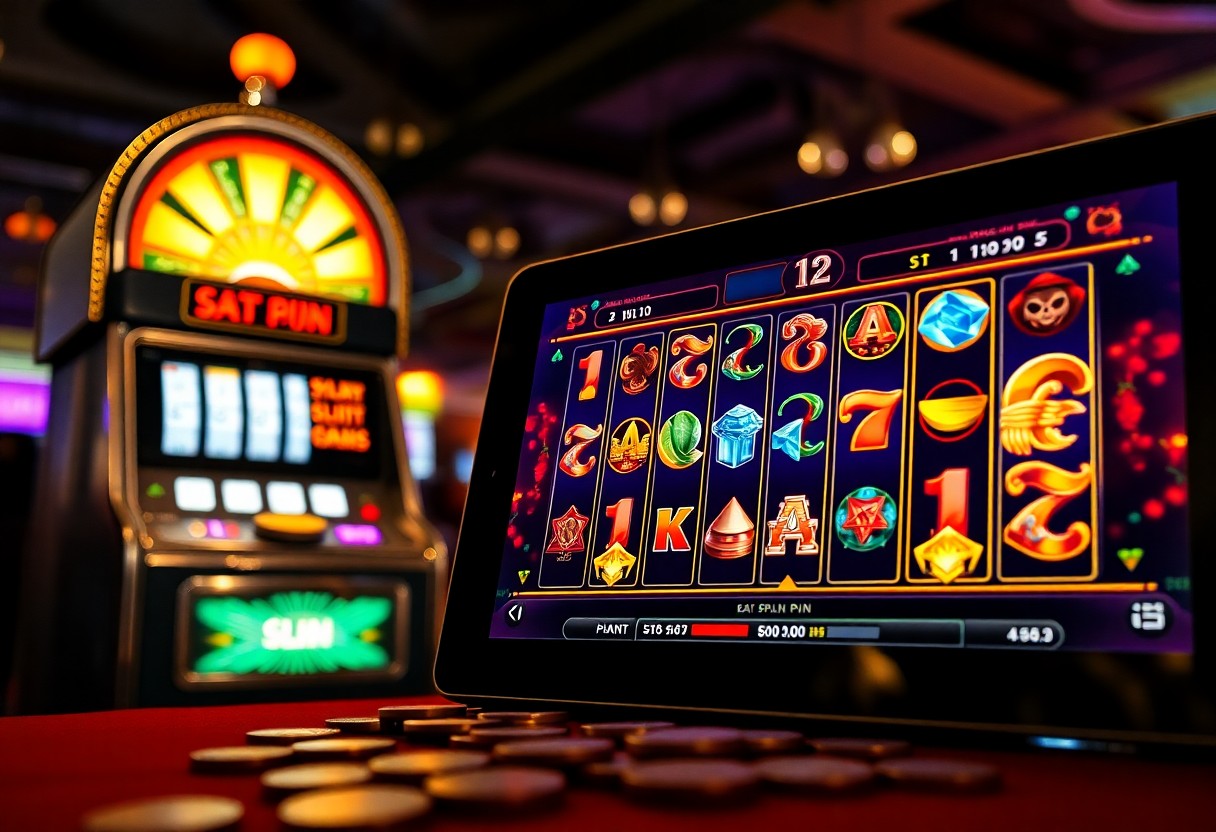Just as technology has transformed many aspects of entertainment, slot games have undergone a remarkable evolution, shifting from traditional mechanical machines to sophisticated online platforms. This journey reflects advancements in design, gameplay, and accessibility, as well as the growing appeal of these games in the digital age. Understanding this evolution provides insights into the mechanics, aesthetics, and cultural significance of slot games today, highlighting their enduring popularity and the innovative features that enhance the player experience.
The Birth of Slot Machines
The birth of slot machines fundamentally changed the landscape of gambling, transforming simple gaming into a captivating experience. In the late 19th century, the first mechanical slots emerged, featuring a straightforward design where players could spin reels to win small prizes, laying the groundwork for a multi-billion dollar industry.
The Mechanical Origins
The first mechanical slot machine, the Liberty Bell, was invented by Charles Fey in 1895. This innovative machine used a system of gears and levers to create a simple yet engaging gameplay experience. With its three spinning reels and five symbols, including horseshoes and bells, it introduced the concept of luck and chance, captivating players and leading to the machine’s widespread popularity.
The Emergence of the One-Armed Bandit
The nickname “one-armed bandit” originated from the popularization of slot machines equipped with a single lever on the side, enabling players to spin the reels. This iconic design became synonymous with gambling establishments in the early 20th century, as these machines offered players the thrill of immediate rewards, typically in the form of coins. The simplicity and allure of the one-armed bandit contributed significantly to its quick adoption in bars, clubs, and eventually casinos, setting the stage for more advanced iterations in the future.
The one-armed bandit revolutionized the gambling experience by providing a straightforward, accessible method of play. Players were drawn to the excitement of pulling the lever, the anticipation of the spinning reels, and the joyous sound of coins spilling out upon winning. By the 1930s, these machines dominated the gaming scene, leading to the establishment of regulations and innovations that shaped the slot machine market. Their combination of luck, chance, and tangible rewards solidified their position as a staple in entertainment venues across America.
The Golden Age of Slots
The Golden Age of slots marked a transformative period during the mid-20th century, where the combination of luck and technology created a dynamic gaming experience that captivated players. Innovations led to the introduction of electromechanical machines, enhancing gameplay and paving the way for more intricate designs. The era also saw the emergence of themed games that attracted a broader audience, making slot machines a staple in casinos and contributing significantly to their revenue.
The Rise of Electromechanical Machines
Electromechanical machines emerged in the 1960s, introducing the use of electric motors and solenoids to replace the mechanical mechanisms of earlier models. This innovation allowed for faster game play, improved payout systems, and the possibility of multiple paylines, which significantly enhanced player engagement. Brands like Bally and IGT were at the forefront, creating machines that set the standard for future developments in slot technology.
Iconic Games and Their Impact
Several iconic games defined this era, leaving a lasting impact on the slot gaming landscape. Titles like “Liberty Bell,” “Money Honey,” and “The Big Bertha” became household names, known for their innovative features such as larger jackpots and engaging themes. These games established a trend of combining entertainment with gambling, greatly influencing the design and features of contemporary slots.
The influence of these iconic games extended beyond mere entertainment; they reshaped gambling culture and increased casino revenues. For instance, “Money Honey” was the first to offer a bottomless hopper, which automated payouts and eliminated the need for attendants. This innovation vastly improved the gaming experience, encouraging longer play sessions. As these machines gained popularity, they also inspired countless clones and adaptations, solidifying the foundation for the modern slot game industry where character-driven narratives and themed gameplay are now standard.
The Transition to Video Slots
With the introduction of video technology in the late 1970s and early 1980s, slot games underwent a significant transformation, evolving from mechanical designs to electronic versions. Video slots featured vibrant graphics, engaging animations, and dynamic audio, enhancing the player experience dramatically. The incorporation of multi-line play and bonus features began to attract a broader audience, paving the way for innovative gameplay that remained rooted in the classic slot machine appeal.
Technological Advancements
Advancements in technology were paramount in the shift to video slots, particularly the use of microprocessors and digital screens. These innovations enabled more complex game mechanics, allowing developers to introduce intricate pay lines and interactive bonus rounds. Graphics became richer with 3D modeling, and sound quality improved significantly, creating an immersive gaming environment that appealed to a new generation of players.
The Popularity Surge
The rise of video slots coincided with a broader acceptance of casino gaming, particularly in the 1990s, leading to explosive popularity. The ability to offer a variety of themes, from movies to mythology, attracted diverse player demographics, while the introduction of progressive jackpots created lucrative opportunities for larger payouts. Casinos reported record revenues as players flocked to these engaging machines, driving industry growth.
The surge in popularity of video slots can be exemplified by the launch of titles like “Mega Moolah” in 2006, which offered progressive jackpots and became known for producing millionaires overnight. In 2019 alone, the global slot machine market reached approximately $51 billion, with video slots accounting for a significant portion of that revenue. This growth reflects not only technological advancements but also a shifting cultural landscape where gaming became a mainstream entertainment choice, introducing millions to the thrill of spinning reels. The connection offered by vibrant themes and storytelling catapulted video slots into a dominant position within the gaming industry, making them a staple in both physical and online casinos alike.
The Digital Revolution
Introduction of Online Slot Games
The rise of the internet in the late 1990s marked a significant turning point for slot games, transitioning from physical machines to online platforms. The first online casinos launched in 1994, providing players with instant access to various slot games from anywhere in the world. This innovation not only expanded game availability but also introduced new themes, designs, and gameplay mechanics, enhancing the overall experience for players. As these platforms evolved, they embraced advanced graphics and sound technology, creating immersive environments previously unattainable in traditional venues.
The Role of Mobile Gaming
Mobile gaming emerged as a game-changer for slot enthusiasts, enabling play on tablets and smartphones. This accessibility led to the growth of mobile-friendly versions of popular games, catering to players who prefer gaming on-the-go. Statistics show that over 50% of online gaming revenue now comes from mobile devices, highlighting the shift in player behavior and preferences.
Mobile gaming has revolutionized the slot experience with apps and responsive websites that allow seamless gameplay anytime, anywhere. Developers focus on optimizing user interfaces for touch controls and creating games that fit smaller screens without sacrificing quality. Features such as social sharing, instant updates, and bonus notifications enhance engagement, keeping players connected and active. Additionally, mobile-exclusive titles often leverage unique touch-and-swipe mechanics, creating innovative gameplay that attracts new audiences. This shift has significantly shaped the slot gaming landscape, making it more accessible and engaging than ever before.
Features and Innovations in Modern Slots
Modern slot games incorporate a plethora of features and innovations that elevate the gaming experience beyond traditional reels. Enhanced graphics, immersive sound effects, and sophisticated game engines create a dynamic environment that captures players’ attention. Additionally, many games now offer intricate mechanics, including cascading reels, multipliers, and interactive features that engage users and provide numerous ways to win. The combination of technology and creativity has transformed slots into versatile entertainment options catering to diverse preferences.
Bonus Rounds and Progressive Jackpots
Bonus rounds have become a staple in modern slot games, offering players chances for additional rewards through interactive gameplay. These rounds may include free spins, mini-games, or pick-and-win features, significantly increasing player engagement. Progressive jackpots, linked across multiple machines or online platforms, have further amplified the excitement, enabling some players to win life-changing sums that can reach millions. The synergy of these features enhances the thrill and draws players back for more.
Theming and Storytelling
Themes in slot games have evolved dramatically, with many titles now incorporating rich storytelling elements. Players can find themselves exploring enchanted forests, initiateing on space adventures, or unraveling ancient mysteries, all while engaging with the game’s mechanics. This storytelling approach not only enriches the experience but also fosters emotional connections to the games, enhancing overall enjoyment and retention.
The integration of themes and narratives presents an immersive experience that extends beyond simple gameplay. For example, games like “Gonzo’s Quest” taps into historical exploration, guiding players through the search for treasure with captivating visuals and soundscapes. Titles such as “Game of Thrones” draw from popular culture, inviting fans to engage with familiar characters and settings. By embedding storytelling deeply into the gameplay, developers foster a compelling connection that can significantly influence player loyalty and enjoyment, contributing to the remarkable success of modern slots.
Regulatory Changes and Online Gaming
As online gaming gained popularity, regulatory frameworks evolved to address the complexities of this burgeoning industry. Governments worldwide recognized the need for legislation to ensure consumer protection and to mitigate potential issues like gambling addiction. Various jurisdictions implemented licensing requirements, tax obligations, and operational standards, creating a balanced environment for both operators and players. This regulatory evolution has significantly influenced the design and marketing of online slot games, ensuring safer gaming experiences while promoting responsible gambling.
Legal Landscape for Online Slots
The legal landscape for online slots is diverse, varying significantly across different regions. In the United States, states like New Jersey and Pennsylvania have established regulated markets, while others maintain strict prohibitions. Conversely, many European countries have embraced online gaming, implementing comprehensive regulatory frameworks. These legal variances impact how operators design their offerings, affecting everything from bonus structures to game availability.
Security and Fair Play Measures
Security and fair play measures are fundamental components of the online slot gaming experience, safeguarding players against fraud. Reputable online casinos employ advanced encryption technologies to protect sensitive data and transactions. These platforms often undergo independent audits to verify game fairness, ensuring that Random Number Generators (RNGs) function correctly, providing players with a truly random and unbiased gameplay experience.
To further enhance security, many online slot developers partner with organizations like eCOGRA and iTech Labs, which certify the fairness and security of games offered. Compliance with these standards not only reassures players but also builds trust within the industry. An increasing number of platforms utilize blockchain technology to create transparent transaction processes, allowing players to verify their game outcomes. Together, these measures create a robust environment where safety and fairness are paramount, fostering player confidence in their gaming choices.
Conclusion
Ultimately, the evolution of slot games from classic machines to modern online slots illustrates a dynamic shift in gaming technology and player engagement. Traditional mechanical devices have paved the way for sophisticated online platforms featuring advanced graphics, interactive features, and diverse themes. This transformation reflects changing consumer preferences and the integration of cutting-edge technology, ensuring that slot games remain a prominent and evolving segment of the gambling industry. As innovation continues, players can expect even more immersive experiences that enhance gameplay and accessibility.
FAQ
Q: What are the main differences between classic slot machines and modern online slots?
A: Classic slot machines typically feature three reels, simple symbols, and limited paylines, focusing on traditional gaming experiences. Modern online slots, however, offer five or more reels, complex graphics, animated themes, a variety of paylines, and innovative features such as bonus rounds and progressive jackpots.
Q: How have themes and graphics evolved in slot games?
A: Slot games have evolved significantly in terms of themes and graphics. Classic machines often featured fruit symbols and simple designs, whereas modern online slots incorporate advanced graphics, 3D animations, and diverse themes ranging from movies and mythology to adventure and fantasy, enhancing the immersive experience for players.
Q: What impact has technology had on the evolution of slot games?
A: Technology has transformed slot games by enabling online play, mobile accessibility, and the use of random number generators for fair outcomes. Advances in software also allow for innovative features such as interactive gameplay, social gaming elements, and virtual reality experiences, vastly expanding the possibilities for player engagement.




